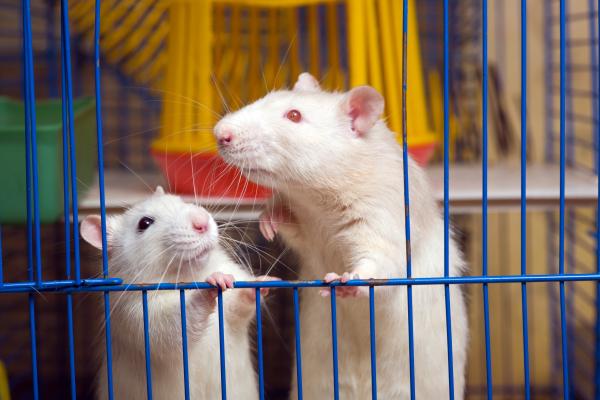
Elements of Behavioral Management
The overall goal of the Animal Welfare Act is to improve the lives of animals used in research, teaching, testing, and exhibition. Therefore, it is important to understand behavioral management of animals as it refers to the broad concept of improving captive animals' welfare. An animal's welfare can be improved in multiple ways, which are further discussed in detail below.
Jump to:
Environmental Enrichment
Environmental enrichment refers to the modification of an animal's physical environment, especially those in captivity, to help meet the animal's behavioral needs and improve their well-being. These enrichments provide a challenge and stimulation to the animals so that their environment becomes more complex and dynamic. Enrichment can be provided in 5 different ways:
- Social: contact vs. no contact (e.g. group or pair housing animals)
- Occupational: physiological (e.g. providing puzzles or playing fetch)
- Physical: enclosure design and objects (e.g. the addition of toys, climbing structures, or nest-building materials)
- Sensory: stimulating senses (e.g. catnip or sounds from natural habitat)
- Nutritional: food (e.g. treats or food presentation)
Animal Welfare Act Requirements for Enrichment
-
Animal Welfare Act Quick Reference Guides
USDA. NAL. Animal Welfare Information Center.
The requirements of the Animal Welfare Act are set forth in the Title 9 Code of Federal Regulations (CFR), Chapter 1, Subchapter A - Animal Welfare. These quick reference guides include the CFR on exercise for dogs and environmental enhancement for nonhuman primates.
-
Environmental Enrichments for Nonhuman Primates: A Resource Guide (updated 2021)(PDF | 973 KB)
USDA. NAL. Animal Welfare Information Center.
This bibliography provides citations regarding environmental enrichment, social housing, training, abnormal behaviors, and stereotypies of nonhuman primate species commonly used in research. It also includes information for online resources, primate organizations, discussion groups, and enrichment products and suppliers.
Environmental Enrichment Literature and Databases
Social Housing

Many animal species used in research, teaching, testing, and exhibition are social animals meaning they like to be with other animals. Single housing of social animals can be harmful to their welfare by causing the animals to become stressed and depressed. Therefore, it is important to understand the social interactions of animals and create environments that allow for group housing when appropriate.
The Animal Welfare Act Regulations require social grouping of certain species such as nonhuman primates and marine mammals unless single housing is justified (e.g. the animal is aggressive towards others). NIH's Office of Laboratory Animal Welfare (OLAW) and AAALAC International also support group housing of social animals.
Annual 3Rs Symposium
AWIC co-hosts an annual 3Rs Symposium. The first 6 symposiums focused on social housing of laboratory animals. Past presentations can be viewed for free.
Past Presentations
Find discussions on microphysiological systems, animal/organ sharing, optimizing breeding, research design and statistical strategies among other topics.
View presentations on liver-chip technologies, environmental health monitoring, refinement and enrichment strategies, regulatory insights into the 3Rs among other topics
Watch presentations on mixed strain housing, best animal models for disease research, adoption programs, collaborating to solve animal welfare issues and other topics
Find talks on 3Rs in machine learning and literature searching, animal models in COVID research, microphysiological systems, assessing animal welfare and other topics
View presentations on minibrain organoids, grimace scales, PRIMatE data exchange, using pets in research, rodent and pig handling, and PREPARE guidelines among other topics
Find discussions on zoo animals, rabbits, mice, and rats
Watch presentations on fish, rats, mice rabbits, and miniature swine
View talks on rabbits and miniature swine
Watch discussions on nonhuman primates, zebrafish, and amphibians
Find talks on ruminants, nonhuman primates, rabbits, guinea pigs, and hamsters
View presentations on rabbits, pigs, and nonhuman primates
Normal and Abnormal Behaviors
Animals perform many different behaviors every day to interact with themselves, other animals, humans, and their environment. An animal’s activity may change based on something they experience. For example, a dog hears a thunderstorm, so it might start panting because it’s nervous.
Each behavior can be categorized as either normal or abnormal. Normal behaviors are actions we expect to see from animals in good welfare, such as playing or grooming. Normal behaviors tell us that an animal is happy, healthy, and relaxed in its environment. When animals become stressed, bored, or sick, they may perform ‘abnormal behaviors’ such as biting, hiding, or pacing. Abnormal actions are not performed often, but when an animal is trying to cope with their negative environment they may perform these behaviors more frequently and with great intensity.
It’s important for us to understand animal behaviors so we can identify the behavior, determine what caused it, and determine if it benefits or harms the animal.
Animal Behavior Literature
Below are results from literature searches on animal behavior, normal behavior, and abnormal behavior. If you want to find literature on these topics for a certain species, you can build upon these search strings by including animal search terms. For example, edit the search and include "(pig OR pigs OR swine OR porcine)" to find information on normal and abnormal behavior of pigs. To learn more about building search strings, visit AWIC's alternatives literature searching page or if you need help finding information, contact us.
Animal Training

Animal training involves teaching an animal to perform a specific behavior or task when given a command. Training can be used with many animals such as, pets; livestock; laboratory animals; zoo, circus, and aquarium animals, etc. There are different types of training that can be used. For example, positive reinforcement training involves rewarding the animal with a treat, toy, or other reward for completing the behavior or task that was asked of them. This method can improve an animal's welfare and helps provide them with the best care.
Animal Training Literature
Below are results from a literature search on training animals. If you want to find literature on this topic for a certain species, you can build upon this search string by including animal search terms. For example, edit the search and include ("nonhuman primate" OR primate OR monkey OR "rhesus macaque") to find information on training nonhuman primates. To learn more about building search strings, visit AWIC's alternatives literature searching page or if you need help finding information, contact us.
Animal Training Resources
-
Training Animals
National Centre for the Replacement, Refinement & Reduction of Animals in Research (NC3Rs).
NC3Rs gives an overview of animal training, its costs and benefits, and a list of selected training resources. -
Animal Training
Disney's Animal Kingdom Theme Park.
Disney outlines their animal training programs and provides information on what training is, how animals learn, and how behavior can be shaped using positive reinforcement.
